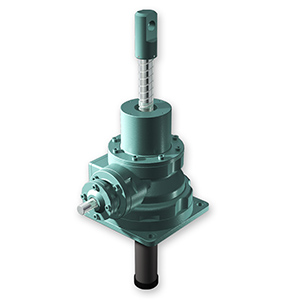Screw Jack
High Speed Jack
Outline
High speed, high frequency, and high efficiency operation increased productivity and contributes to energy saving and environmental measures. The jack can be used not only for ordinary lifting, but also for various purposes.
Features
- – Capacity: 5kN~50kN
- – Lifting screw speed: Max 20m/min)
- – Compared to the Ball Screw jack it is 5 times faster.
- – Duty cycle: Max 70% ED
- – Has 5 times duty cycle compared to the conventional product
- – Input rotation speed: Max 2000~3000min-1
- – Can be used for wide-ranging operations by utilizing a servomotor.
- – This type of jack does not have a self-locking function, so it is required to install a brake.
Specifications
| Series/Size Code | JSH | J0H | J1H | J2H |
|---|---|---|---|---|
| Capacity | 5kN | 10kN | 25kN | 50kN |
| Lifting screw diameter | 20mm | 25mm | 36mm | 40mm |
| Lifting screw lead | 20mm | 25mm | 36mm | 40mm |
| Gear Ratio | 3 | 3 | 3.64 | 4 |
| Effciency | 0.81 | 0.81 | 0.81 | 0.81 |
| Maximum allowable power | 1.3kW | 1.6kW | 2.5kW | 3.3kW |
| Torque coefficient (a) | 1.45 | 1.81 | 2.18 | 2.18 |
| Inertia moment (kg·m2) | 0.0009 | 0.0025 | 0.0093 | 0.0189 |
| Standard Capacity torque *1 | 7.3N・m | 18N・m | 55N・m | 109N・m |
| Allowable acceleration torque *1 | 8.0N・m | 20N・m | 60N・m | 120N・m |
| Required input torque at maximum load | 6N・m | 15N・m | 43N・m | 86N・m |
| Speed coefficient (c) (screw lead per rotation of input shaft) |
6.67mm | 8.33mm | 10mm | 10mm |
| Maximum allowable input rotation speed | 3000min-1 | 2400min-1 | 2000min-1 | 2000min-1 |
| Anti-rotation key torque at maximum load | 2.5N・m | 6.3N・m | 22.5N・m | 50N・m |
| Input shaft allowable overhang load | 120N | 150N | 400N | 800N |
| Amount of filled grease | 20g | 25g | 45g | 80g |
| Amount of oil | 0.1ℓ | 0.3ℓ | 0.5ℓ | 1.8ℓ |
| Approximate weight (at stroke of 100) |
15kg | 20kg | 45kg | 95kg |
| Operating temperature range | -10〜50℃ | -10〜50℃ | -10〜50℃ | -10〜50℃ |
*1: Calculated by deducting “input shaft torque at no load” from “required input shaft torque” (as per the formula shown in Step 2).



